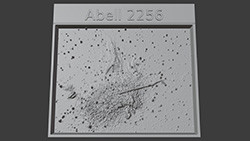CXC Home | Search | Help | Image Use Policy | Latest Images | Privacy | Accessibility | Glossary | Q&A
1
X-ray, Radio, & Optical Images of Abell 2256Credit: X-ray: Chandra: NASA/CXC/Univ. of Bologna/K. Rajpurohit et al.; XMM-Newton: ESA/XMM-Newton/Univ. of Bologna/K. Rajpurohit et al. Radio: LOFAR: LOFAR/ASTRON; GMRT: NCRA/TIFR/GMRT; VLA: NSF/NRAO/VLA; Optical/IR: Pan-STARRS
Data from Chandra, XMM-Newton and three radio telescopes – LOFAR, the GMRT and the VLA – are helping astronomers to understand an ongoing collision of at least three galaxy clusters. These images show X-ray and radio data, plus optical and infrared data from Pan-STARRS. X-rays reveal the superheated gas within the clusters, while the radio emission arises from a complex set of sources including particles blasting away from supermassive black holes. This jumbled scene of mergers and collisions represents the main way that galaxy clusters grow into some of the Universe’s largest structures.
2
3D Printable Files: Abell 2256 (3D Print Credit: NASA/CXC/A. Jubett, using software by Tactile Universe/N. Bonne & C. Krawczyk & Blender)
Abell 2256 is a collision of galaxy clusters about 780 million light-years away. This tactile plate depicts Abell 2256 as a physical relief map based on the intensity of X-ray data captured by Chandra as well as radio, optical and infrared data. The file for this plate can be downloaded and 3D-printed for learners to touch.
This plate features a composite image of at least three galaxy clusters colliding in a jumbled scene. The resulting giant galaxy cluster, Abell 2256, resembles a grainy, pixelated cloud topped with licks of flaming hair. The “hair,” or relics, are the results of shockwaves, likely generated by the collision of gas from the different clusters. Near the lower left sits the oval-shaped cloud, the center of the combined galaxy cluster. Shooting out of the giant cluster, angled toward our upper-middle right, is a straight, thin line. This is a jet; a stream of particles blasting away from a giant black hole. A second, much shorter jet crosses the tip of the first jet near the right-hand side of the image.
In the giant cluster, on the right hand side, are several irregular shapes. These are filaments, the result of jets interacting with gas. Three other irregular filaments can be found to our left, just outside of the giant cluster.
This plate features a composite image of at least three galaxy clusters colliding in a jumbled scene. The resulting giant galaxy cluster, Abell 2256, resembles a grainy, pixelated cloud topped with licks of flaming hair. The “hair,” or relics, are the results of shockwaves, likely generated by the collision of gas from the different clusters. Near the lower left sits the oval-shaped cloud, the center of the combined galaxy cluster. Shooting out of the giant cluster, angled toward our upper-middle right, is a straight, thin line. This is a jet; a stream of particles blasting away from a giant black hole. A second, much shorter jet crosses the tip of the first jet near the right-hand side of the image.
In the giant cluster, on the right hand side, are several irregular shapes. These are filaments, the result of jets interacting with gas. Three other irregular filaments can be found to our left, just outside of the giant cluster.
Return to: Untangling a Knot of Galaxy Clusters (January 30, 2023)











